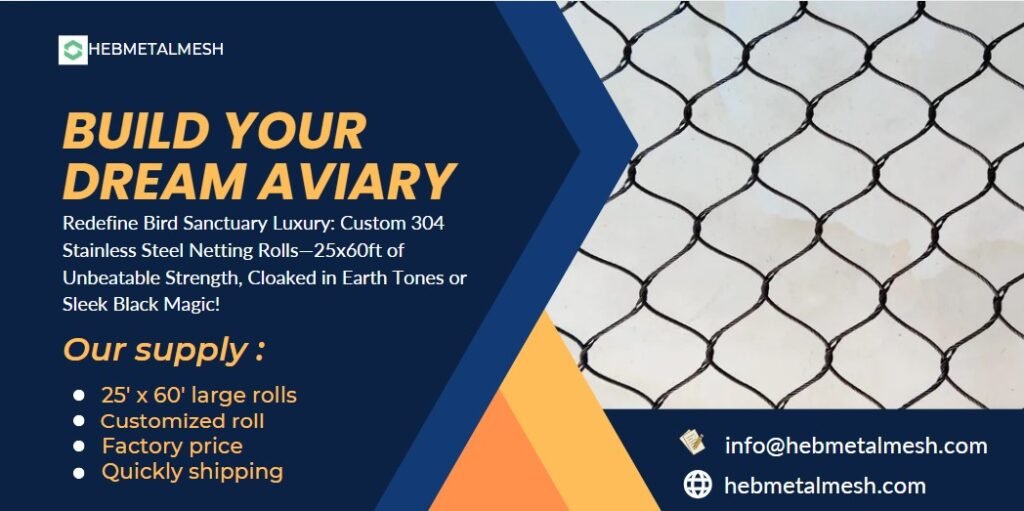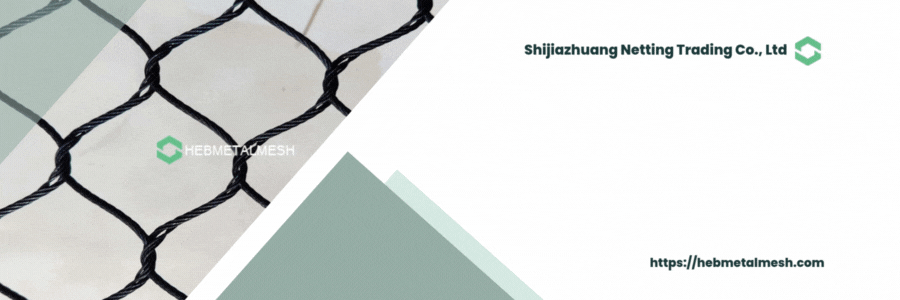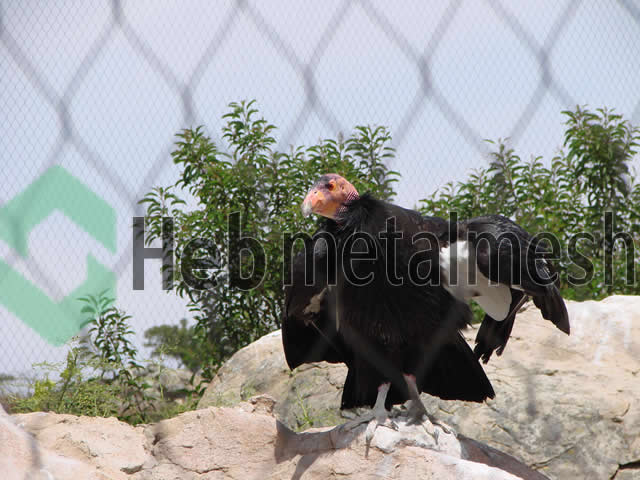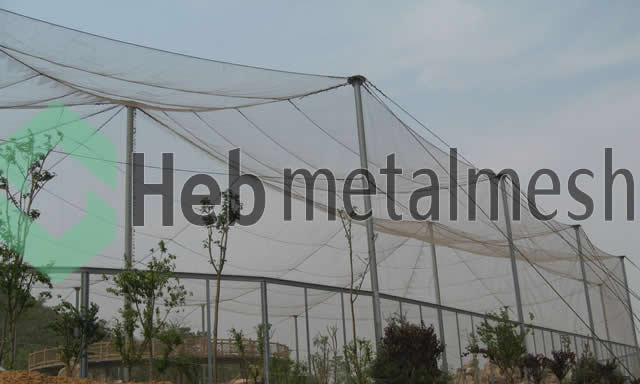Introduction
“Building a safe, long-lasting outdoor aviary? Discover why stainless steel wire rope mesh is the #1 choice for bird enthusiasts and professionals.”
Creating an outdoor aviary is more than just constructing a cage—it’s about designing a sanctuary that prioritizes safety, durability, and natural beauty. Whether you’re housing finches, parakeets, or exotic birds, the wrong materials can lead to escapes, predator attacks, or costly replacements. This is where 304 stainless steel wire rope mesh shines. With its 30+ year lifespan, 1″x1″x1/16″ sizing for small birds, and resistance to rust and weather, it’s the ultimate solution for aviary builds.
In this guide, we’ll explore why stainless steel mesh outperforms alternatives like galvanized steel or plastic, how to design a functional and visually appealing aviary, and why investing in quality materials saves money (and stress) long-term.
Why Stainless Steel Wire Rope Mesh is Ideal for Outdoor Aviaries
1. Unmatched Durability
304 stainless steel is engineered to withstand the harshest outdoor conditions. Unlike galvanized steel, which rusts after 5–10 years, stainless steel resists:
- Corrosion from rain, humidity, or coastal salt air.
- UV degradation that weakens plastics.
- Temperature extremes (-100°F to 1600°F).
This means your aviary mesh won’t warp, crack, or stain, even after decades of use.
2. Safety First
Birds are delicate, and their enclosures must eliminate risks:
- Smooth, burr-free edges: Prevent cuts or feather damage.
- Predator-proof strength: 1/16″ thick wires resist raccoons, hawks, and snakes.
- Non-toxic material: Safe for birds that chew or peck surfaces.
3. Aesthetic Flexibility
Stainless steel’s sleek, metallic finish blends seamlessly into gardens, zoos, or commercial spaces. Unlike rust-stained galvanized mesh, it maintains a polished look without constant cleaning.
The Perfect Mesh Size: 1″x 1″x 1/16″ Explained
Why 1″x 1″ Mesh?
- Prevents escapes: Small birds like finches or canaries can’t squeeze through.
- Blocks predators: Keeps out rodents, snakes, and larger birds.
- Optimal visibility: Allows clear viewing without obstructing airflow or sunlight.
Why 1/16″ Thickness?
This gauge strikes the perfect balance:
- Strength: Supports climbing birds like parrots.
- Lightweight: Reduces strain on frames.
- Flexibility: Allows curved designs (domes, tunnels).
Material Comparison
| Feature | 304 Stainless Steel | Galvanized Steel | Plastic/PVC |
|---|---|---|---|
| Lifespan | 30+ years | 5–10 years | 2–5 years |
| Weather Resistance | Excellent | Moderate | Poor (UV damage) |
| Safety | Non-toxic, smooth | Sharp edges, zinc risks | Chewed by rodents |
| Cost Over 30 Years | $1,000 (one-time) | $3,000+ (replacements) | $5,000+ (replacements) |
Benefits of 304 Stainless Steel for Long-Term Use
1. Corrosion Resistance
304 stainless steel contains 18% chromium and 8% nickel, forming a protective oxide layer that self-heals when scratched. It withstands:
- Saltwater spray (ideal for coastal aviaries).
- Acid rain or fertilizers used in garden settings.
- Humid climates without trapping moisture.
2. Low Maintenance
Forget scrubbing rust or replacing panels:
- Cleaning: Hose down debris; no chemicals needed.
- No coatings: Unlike galvanized steel, it won’t flake or peel.
3. Eco-Friendly
Stainless steel is 100% recyclable, making it a sustainable choice for eco-conscious bird owners.
Design Tips for a Functional & Beautiful Outdoor Aviary
1. Pair with the Right Frame
Use powder-coated aluminum or stainless steel frames to avoid galvanic corrosion. Ensure joints are welded or clamped securely.
2. Integrate Natural Landscaping
- Add non-toxic plants (e.g., bamboo, ferns) for shade and enrichment.
- Install perches at varying heights to mimic natural habitats.
- Include a shallow water feature for bathing.
3. Custom Shapes
Stainless steel’s flexibility allows for creative designs:
- Curved roofs: Prevent snow buildup.
- Multi-level platforms: Encourage flight and exploration.
- Tunnels: Connect multiple aviaries safely.

Installation & Maintenance Guide
Step 1: Secure the Mesh
- Use stainless steel clamps or hog rings to attach mesh to frames.
- Avoid over-tensioning, which can create gaps.
Step 2: Check for Gaps
Inspect seams monthly, especially after storms. Birds can escape through holes as small as ½”.
Step 3: Clean Regularly
- Rinse with water every 2–3 months.
- For stubborn dirt, use a soft brush and mild soap.
Cost Analysis: Why Stainless Steel Saves Money
While stainless steel costs 2–3x more upfront than galvanized mesh, its 30+ year lifespan means:
- No replacements: Galvanized steel requires 3–6 replacements in 30 years.
- Lower labor costs: Install once, forget maintenance.
Case Study: The XYZ Aviary reduced long-term costs by 60% after switching to stainless steel in 2010.
FAQs
Yes! The spacing is too small for finches to escape, yet allows ample airflow.
Absolutely. Its high tensile strength (up to 220 ksi) supports heavy snow loads without sagging.
Most suppliers offer custom-cut panels for arches, domes, or angled designs.
Conclusion
For a durable, safe outdoor aviary, 304 stainless steel wire rope mesh is unbeatable. With its 1″x1″x1/16″ construction, 30+ year lifespan, and sleek design, it’s the ultimate investment for bird lovers.
CTA: Ready to build your dream aviary? Explore our stainless steel mesh kits today and enjoy peace of mind for decades!



